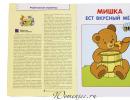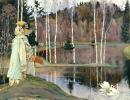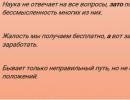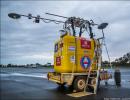Virtual walk through the autumn forest presentation. Presentation on familiarization with the surrounding world “Walk through the forest”
Abstract of GCD in the senior group on the topic: "Walk in the autumn forest"
This material will be useful for educators when conducting classes in the senior group. It was carried out with pupils as part of the thematic week “Golden Autumn”.
Summary of direct educational activities “Walk in the autumn forest” in the senior group
Compiled and conducted: Aksenova Tatyana Anatolyevna, teacher of the 1st qualification category of the municipal budgetary preschool educational institution, general developmental kindergarten No. 95 “Rostochek”, Volzhsky, Volgograd regionProgram content: Expand children's understanding of the diversity of the plant world. To form the idea that for a person, an environmentally friendly environment is a factor of health. To provide knowledge about the species diversity of forests: deciduous, coniferous, mixed. Learn to name the distinctive features of trees and shrubs. Develop a caring attitude towards nature. Systematize knowledge about the benefits of forests in the lives of humans and animals, about correct behavior in the forest.
Preliminary work. Conversation, reading works of art about nature. Didactic games. Guessing riddles. Conversation about rules of conduct in the forest. Learning the physical education lesson “Our little forest is so good!”
Material and equipment: laptop; media projector; slides depicting forests, deciduous and coniferous trees, shrubs, mushrooms, berries and herbaceous plants; path map
GCD move:
An audio recording of forest sounds is played. The teacher asks a riddle:
The house is open on all sides.
It is covered with a carved roof.
Come to the green house -
You will see miracles in it. (Children: Forest)
Educator: That's right, today we will remember everything we know about the forest kingdom. Why does a person need a forest? (Children's answers)
The teacher draws attention to the media projector screen, which depicts a forest. Sums it up.: “You and I came to the forest. The forest welcomes everyone in its domain in a friendly and welcoming manner: it protects from the scorching rays of the sun, reveals many mysteries, and treats everyone with forest gifts. The forest is the habitat of many forest animals and birds. This is their home, where they breed, find food and protection. The forest is man's true friend. Walking in the forest is very important for people's health. The forest is the home of animals and plants. The forest is the farmer's friend. The forest is the decoration of the planet!”
Draws the children's attention to the fact that on the stump there is a letter addressed to them from the old man Lesovich.
Reads the letter aloud:“Dear senior students! Old man Lesovichok is writing to you. I live in the forest and I will be very glad if you come to visit me. I love the forest very much and I’m always happy to have guests! Sincerely, old man Lesovichok.”
Invites children to remember the rules of behavior in the forest and go for a walk.Educator: I have special signs. I will show cards with signs, and you will tell us how to behave in the forest.
- You can't make noise in the forest.
- You can't litter in the forest.
- You can't light a fire.
- You can't destroy birds' nests.
- Plants cannot be uprooted.
- You can't break tree branches.
- In the forest you need to walk along the paths, looking at your feet.
Child 1:
If you come to the forest for a walk, breathe fresh air,
Run, jump and play, just don’t forget,
that you can’t make noise in the forest. even sing very loudly!
The little animals will get scared and run away from the forest edge.
Do not break spruce branches. and remember more often:
Child 2:
Remove trash from the grass! No need to pick flowers!
Don't shoot with a slingshot, you didn't come to kill!
Let the butterflies fly, Who are they bothering?
here you don’t need to catch everyone, stomp, clap, beat with a stick.
You are just a guest in the forest. Here the owner is spruce and elk.
Take care of their peace, After all, they are not our enemies!
Educator: Guys, today I suggest going for a walk in the forest. - Wear down jackets and hats with earflaps. - What's happened? (We don’t have down jackets or warm hats.). - Why? (Warm). - What should we wear? (Jackets, knitted hats). - What clothes? (Autumn). - From shoes? (Rubber boots, sneakers). - And boots, for what time of year? (For winter). Well, what are you wearing? (Yes). What is the best way for us to get to the forest? (There is a discussion of the problem. We come to the conclusion that a bicycle is the best transport for a walk, because it is silent, does not pollute the air, and is easy to avoid obstacles.) We sit on bicycles. (children imitate the movements of riding a bicycle). A picture of a forest is projected onto the screen. The teacher reads:
Our little forest is so good!
You won't find a better forest!
We have things to do in the forest,
We can't live without a forest.
We will protect the forest and help everyone together,
Both animals and birds will need help.
You grow up to be a joy to people,
We will be friends with you,
Good forest, mighty forest,
Full of fairy tales and miracles!
Educator: Notice how beautiful and quiet it is in the forest. Let's walk along the paths. First, let's go with our eyes along the blue path, then along the red one, turn around and go along the green one.

He asks what is the name of the forest where birch, maple, oak, and rowan trees grow? Summarizes the children's answers:“Such a forest is called deciduous because deciduous trees and shrubs grow in it.”
Deciduous trees on the media projector screen.
The teacher asks what other types of trees the children know. Summarizes the children's answers:“Coniferous trees are pine, cedar, spruce, fir and others. Such a forest is called coniferous.”
There are coniferous trees on the media projector screen.
The teacher asks:“What is the name of a forest in which deciduous and coniferous trees grow? What forest are we walking in? Deciduous and coniferous trees grow in a mixed forest; we are walking in a mixed forest. The teacher leads children to understand that by maintaining cleanliness and order in the forest, we thereby help plants and animals.
A picture of a mixed forest is projected onto the screen.
Educator: Walking in the forest is very good for health. Let's take a walk in the clearing.
Physical education minute.
We'll take the baskets
Let's go to the forest to pick berries. (Children walk in a circle one after another.)
One two three four five,
Let's look for berries. (They stop, perform a “spring”, clap their hands.)
Let's run down the path (They run in a circle.)
Let's jump over the puddles. (They jump on two legs.)
We'll look under the leaves - (They squat.)
Let's pick some berries for dinner: (Imitate picking berries.)
Blackberries and raspberries,
Blueberries and viburnums. (They walk in place.)
Bunches of ripe lingonberries
And some strawberries. (They perform a “spring” and clap their hands.)
There are bushes on the media projector screen.
The teacher asks:“What is the difference between trees and shrubs? That's right, a tree has one trunk coming from its root, and a bush has several rather thin stems - stems. What shrubs do you know? Tell us about the shrubs - hawthorn, blackberry, sea buckthorn, lilac, rose hips and others. (Children's answers.) Raspberries and currants are also shrubs. They grow both in the forest and in the country. The fruits (berries) of these shrubs are very tasty and healthy. What other berries grow in the forest? (Strawberries, blueberries, blueberries, lingonberries.)
The teacher asks:“What other plants are there in the forest? That's right, mushrooms. Mushrooms are edible and inedible. Mushroom pickers carefully cut them off with a knife so as not to damage the root (mycelium). Then mushrooms will still grow in this place. People and forest dwellers eat mushrooms. Squirrels especially love mushrooms. She even dries them for the winter and puts them in her hollow.”
There are berries and mushrooms on the media projector screen.
The teacher asks:“What other plants are there in the forest? (Children's answers.) Herbaceous plants, dandelion, plantain, bellflower, have soft, succulent stems. There are many beautiful herbaceous plants in the forest that bloom very beautifully!”
There are herbaceous plants on the media projector screen.
The teacher draws the children’s attention to the fact that on the tree stump there is again a letter from old man Lesovich, and reads it out:"Guys! How you made me happy - you followed all the rules of behavior in the forest. I want to give you pictures of forest plants. I suggest coloring all the plants and, together with adults, designing the book “Plants of the Forest.” This book will help you understand the amazing world of nature even better. And I always look forward to your visit. Walking in the forest is very useful for children and adults! All the best! Sincerely, old man Lesovichok.”
The teacher invites children to color pictures of plants in their free time and create a collage “Autumn Forest”.
Olga Stepanyuk
Presentation on familiarization with the surrounding world “Walk through the forest”
Presentation on getting to know the world around you. Senior group.
Theme: "Walk in the Woods"
Regions:
Cognitive development:
Expand children's understanding of the diversity of the plant world.
To provide knowledge about the species diversity of forests: coniferous, deciduous, mixed.
To form the idea that for a person, an environmentally friendly environment is a factor of health.
Learn to name the distinctive features of trees and shrubs.
Develop a caring attitude towards nature.
Physical development:
Maintain and strengthen physical and mental health
Social and communicative development:
Systematize knowledge about the benefits of forests in the lives of humans and animals, about correct behavior in the forest.
Activating the dictionary:
Introducing new words - coniferous, deciduous, mixed.
Literature
Solomennikova O. A. Introduction to nature in kindergarten. Senior group. – M.: MOSAIKA-SYNTHESIS, 2015. – 112 p. (page 42)
Publications on the topic:
Familiarization with the outside world in the second junior group. Entertainment “Walk through the spring forest” Entertainment in the second junior group “Zadorinka” and “Sun” “Walk through the spring forest” Purpose: To consolidate children’s knowledge about the characteristic features.
Presentation of the ORU “Walk in the Woods” Presentation for the entertaining warm-up "Walk in the Forest" for children 4 years old. Visual material. For an entertaining warm-up “Walk.
Presentation on familiarization with the environment for children with hearing impairment “Spring” Presentation vocabulary: What time of year? Spring. Snow is melting. Thawed patches appeared. Icicles. Icicles are hanging. Drops. Streams flow. The boat is sailing.
To use presentation previews, create a Google account and log in to it: https://accounts.google.com
Slide captions:
A walk in the forest Performed by the teacher of the 1st category of the MDOU “Kindergarten of a combined type No. 54”, Saratov Dementyeva Valentina Vladimirovna.
Rules of behavior in the forest
The trunk turns white, the cap turns green. Standing in white clothes, dangling earrings. I put on orange beads for autumn with a slightly bitter but pleasant taste. In winter, the Bullfinch, the Great Bird, the Jay and the Tit will be able to enjoy them.
He is in the forest, like a hero - all huge - up and down! The leaf is beautiful, cut, green in summer and spring. The autumn giant is glad to put on his brown outfit. From the branches, as if for fun, he scatters acorns. In hot summer it is green, with a lush and shady crown. In autumn it is yellow, red or orange - beautiful! Later, he drops the leaves like gloves in disarray. Anyway, what is his name? Did you guess it? This is... (maple).
Deciduous forest Hello, forest, dense forest, Full of fairy tales and miracles! What are you making noise about in the leaves on a dark, stormy night? What are you whispering at dawn, covered in dew like silver? Who is hiding in your wilderness? What kind of animal? What bird? Open everything, don’t hide it: You see, we are our own!
The common spruce is arrogant from a distance, but close up it’s a cozy home... Here we’ll wait out the rain. Y. Nasimovich Pines want to grow to the sky, They want to sweep the sky with branches, So that the weather will be clear throughout the year. Tokmakova I.
Coniferous forest In the coniferous forest, where there is peace and coolness, Pines and spruces stand in rank. They don’t need a change of outfits, They look with longing at the spring ceremony. The stern maidens bowed to the winter wind in the rays of silence. The slender trees will hardly be touched by the sonorous trills of the messengers of spring.
Mixed forest So the birches cling to the pines, They twisted their braids with moss, And, beautiful earrings - They awaken love in the pines! They gently touch the emerald beauty, And the fluffy ones nod, Bow their heads to the foliage.
Physical exercise “Walk in the forest” We will rest a little, (Stand up, legs together, hands) Let’s stand up and take a deep breath. (through the sides - up - inhale, lower down - exhale) The children walked through the forest, (Walking in place,) Watched nature. (Turn your head left and right) They looked up at the sun (Stand on your toes, arms across your sides) And their rays warmed them. (up and look up.) We have miracles in the world (Sit down, hands on your belt.) Children have become dwarfs. And then everyone stood up together (Stand on tiptoes, hands on waist) We became giants. (back straight, stretch up.) Butterflies flew, (Running in place, smoothly waving their arms.) They waved their wings. Let's clap together, (Clap our hands,) Stomp our feet. (The floods are in place.) We had a good walk (The children sit down in their places) And we were a little tired. (And listen to the birds singing.)
Shrubs The main difference between a shrub and a tree is that a shrub does not have a clearly defined main stem (trunk). The bush has many thin trunks immediately extending from the root, forming a bush. By this very characteristic feature you can always easily distinguish a shrub from a tree.
Herbaceous plants
Boletus mushrooms A mushroom picker hurries into the autumn forest to hunt with a box. The mushroom picker wants to find a large clean...(boletus). Fly agaric Look how good it is! Red polka dot hat, lace collar - He's no stranger to the forest!
Physical exercise “For raspberries”. Let's go to the forest for raspberries, let's go to the forest. (children dance in a circle holding hands) Let’s pick up some ripe berries, let’s pick them up. (they walk in a circle, bending down, as if picking berries) The sun is high, (they stand facing in a circle, stretching their arms up) And there is a path in the forest. (they bend down and try to reach the floor) My sweet one, (they walk in a circle, holding hands) Raspberry berry.
On the topic: methodological developments, presentations and notes
Conversation with children of senior preschool age in the educational area "Cognition" "What grows in the forest?" Who grows in the forest?"
Goal: To clarify ideas about the forest as a community in which plants (trees, bushes, herbs, mushrooms) and animals (animals, birds, insects, amphibians) live. Learn to establish the simplest causal...
Conversation about the forest and rules of behavior in the forest
Material about the inhabitants of the forest: trees, insects, birds, animals, mushrooms, berries growing in the forest and caring for them, about the rules of behavior in the forest....






